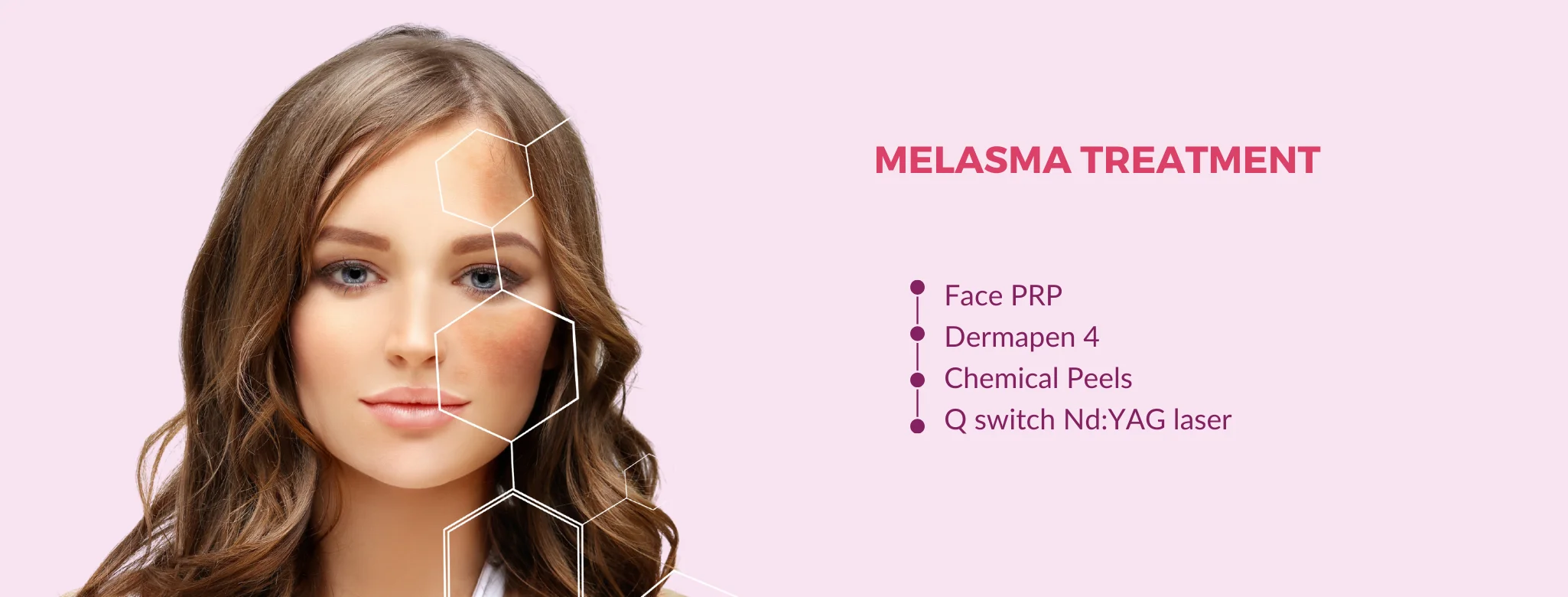
Best Treatment For Melasma On Face
Face Pigmentation Treatment & Cost Of Melasma Treatment in Delhi
Melasma is a very common condition affecting middle-aged people. Melasma occurs between the age of 20 and 40 years. It is more commonly seen in females than in males.
It is a skin problem that can lead to considerable embarrassment and distress.
What is Melasma?
Melasma is a chronic skin disorder that results in symmetrical, brownish patches on the face, mainly affecting the cheeks, nose, forehead, and upper lip area. It is also called the mask of pregnancy as it is common in women during and post-pregnancy.
What causes melasma?
Melasma is a complex skin condition with many causes that leads to its pigmentation.
There is evidence of a strong genetic predisposition to melasma. One in every three people reports a positive family history.
It commonly arises in healthy adults. Chronic sun exposure leads to increased deposition of melanin pigment within the dermis, which persists for long-term. Exposure to ultraviolet radiation (UVR) worsens pigmentation because it activates the melanocyte cells in the skin to produce more melanin.
The various triggering factors include:
Sun exposure and sun damage
Pregnant women
Hormone treatments
Certain medications
Scented soaps and Cosmetics
Hypothyroidism
How does melasma look like?
It presents as irregular, light to dark brown skin-colored patches present on both sides of the face.
The most common area to be affected includes the malar area (cheeks), followed by the nose, forehead, and upper lip.
It might be also associated with prominent vessels in the background.
What are the types of Melasma?
There are 3 types of melasma.
- Superficial
- Deep
- Mixed
Superficial melasma:
In this type, the excess melanin pigment is deposited mainly in the upper layers of the skin called the epidermis. It appears like light to dark brown colored patches. Because the pigment deposition is superficial, it is relatively easy to treat.
Deep melasma:
In this type, the melanin pigment is deposited in the deeper layer of the skin called the dermis. It appears like greyish to black colored patches. It responds partially to the treatment.
Mixed melasma:
This is the most common type of melasma affecting people. In this, the excess melanin pigment is present in both superficial and deeper layers of skin.
How can I get rid of melasma?
It is usually very slow to respond to treatment, especially if it has been present for a long duration.
Generally, a combination of various treatment modalities is required to get the best results in cases of melasma.
- Topical and oral medication
- Chemical peeling
- Photofacial
- Microneedling
- Face PRP
- Q-switched laser
- Fractional lasers
What is the best treatment for melasma?
It is a very difficult condition to treat. A single treatment is rarely helpful in getting rid of melasma.
Combination creams with a series of chemical peels and micro-needling have given great results in our clinical practice. These treatments work on two major principles:
- Inhibiting the activity of melanocyte cells.
- Increasing the exfoliation of pigment-containing cells.
All treatments done at Skinos are as per American Academy of Dermatology guidelines.
How effective is the laser in the treatment of melasma?
Fractional and Q-switched lasers are the most commonly used lasers in the management of melasma. But, laser treatment is associated with lots of heat generation in the skin manifesting as redness, which increases the risk of post-inflammatory hyperpigmentation and may continue to develop melasma. This can be a paradoxical side effect of using a laser in melasma!
Hence, lasers are usually not the first choice of treatment in people with skin type 4 and above.
On the contrary, the other physical modalities like chemical peeling, micro-needling, face PRP, and even photo facial, are safe as well as very effective in improving the pigmentation.
What is the role of sunscreens?
Sunscreen plays a very vital role in melasma management. As we all know that UV exposure precipitates as well as exacerbates pigmentation, so one can understand the importance of using regular sunscreen.
What is the best sunscreen that should be used?
For people with melasma, it is advisable to use a broad-spectrum sunscreen, preferably a sunblock that gives protection against UVA, UVB, as well as visible light rays. SPF 30+.
Recently, many studies are indicating the role of infrared (IR) rays in the worsening of melasma pigmentation, so one should use a sunscreen which also has some anti-oxidants like vitamin A, and E, to get that additional protection against IR rays.
Using sunscreen alone is not enough!
To avail the maximum benefits of sunscreen, you should know how to use it.
Following are the correct methods of using a sunscreen:
- Apply the sunscreen on all the exposed areas of the body not protected by clothing
- Apply a generous amount evenly
- Sunscreen should be applied daily, 365 days a year, even when you stay indoor or its cloudy or rainy
- Apply it at least 15 minutes before stepping out of the house
- Re-apply every 2 hours, especially after immersion in water or excessive sweating sweating
- Additionally, make use of other physical methods of photoprotection, like avoid going out between 11 am to 3 pm, using a broad-brimmed hat, covering the face with a scarf, and staying under the shade as much as possible.
Are the results of melasma treatment permanent?
Results take time, and the treatment of melasma include multiple sessions of the above measures.
The chances of recurrence are present if proper sun protection is not taken, or if there occurs any hormonal imbalances. Continuous research is going on to discover newer topical and oral agents for its effective treatment in the future.
How to cure melasma from inside at home?
There are several home remedies to treat melasma. The natural remedies are as follows:
- Apple Cider Vinegar
- Aloe Vera
- Red Onion
- Green Tea Extract
- Black Tea Water
- Licorice Extract
- Milk
- Tomato paste
- Orchid Extract
- Red Lentils
What Our Patients Say
Nothing gives us more pleasure than the happiness and gratitude expressed by our clients at the end of their Skin, Hair, and Laser treatment!

I recommend Dr. Shruti Gupta because she explains everything related to my problems patiently and p...
Divya Sonkar
Studentaaa
First of all I would like to thank Dr Shruti Gupta Mam for giving me a new life. On the advice of my...
Dinesh
DU Student
Dr.Shruti is very humble and adorable to everyone she explains everything wonderfully, and answers a...
Mukta Rathee
MBBS Student
It was a pleasant experience. Your work is par above my expectations. My exuberant hair growth gives...
Mohit Shukla
DJ
I have acne issue from last 13 year's I tried all from the to homemade solution but nothing's work a...
Sonal Wahi
SQ - CA25000 +
Happy Clients
5
Qualified Doctors
9
Luxury Suites
50 +
Authorized Partners

